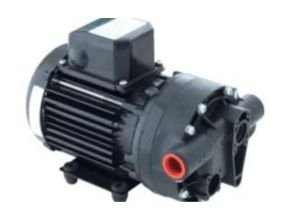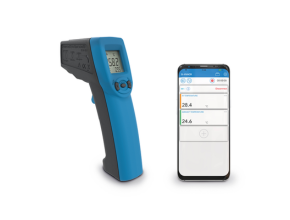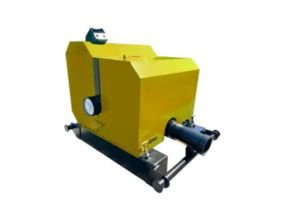Positive displacement pumps are divided into two categories reciprocating pumps and rotary pumps. Positive displacement pumps are characterized by an almost constant flow with fluctuating back pressure. A back-flow of the medium during the standstill of the pump is prevented by the rotary valves or piston itself. Positive displacement pumps are usually self-priming.
Diaphragm pumps
The electric diaphragm pump is a pump that operates according to displacement. Axial deformation of the diaphragm, the pumping chamber medium is displaced to the discharge line.

Air-operated diaphragm pumps
Air-operated diaphragm pumps are pumps that operate according to displacement. Compressed air flows alternately in two membranes. Axial deformation of the diaphragm, the pumping chamber medium is transferred to the discharge line.

After the discharge of compressed air behind the diaphragm, the diaphragm is returned to its original state, and the medium is sucked into the pumping chamber. The valve prevents the backflow of liquid. The diaphragm is a sealing element to the atmosphere. Diaphragm pumps can be self-priming and are suitable for dry operation.
Impeller pumps
Impeller Pumps are rotary positive displacement pumps with pulsation-free and continuous flow. The flexible impeller rotates an eccentrically arranged feed chamber. The vanes of the impeller turn at the costs associated with the eccentric arrangement bottleneck and the pumped liquid is pressed out.

If the blades open again in the further course, a new medium is drawn … The direction is reversible. The pump also media containing particles such. Ex. Beer remains, seeds or stems. The pumps are self-priming and designed for short-term dry running
Microannular gear pumps
Micro annular gear pumps are positive displacement rotary miniaturized. They are based on the so-called micro annular gear principle with an externally toothed internal rotor and an internally toothed outer rotor. The inner rotor has one less tooth than the outer rotor. To use the gear ratios get 6/7 and 10/11. The manufacturing tolerances of the rotors are a few microns in the area.

The product range includes five series of micro annular gear pumps for metering and promoting low-volume liquid low to high-viscosity media. With different equipment dosing volumes are from 0.25 .mu.l, flow rates of 1 ul / h to 1.1 l / min, and pressures from 0 to max. 150 bar feasible. The range of media viscosity ranges from 0.3 to 1,000,000 mPas.
They are suitable for lubricating and nonlubricating liquids. Operation in an explosion-proof area is also possible. The pumps are characterized by low pulsation, low-shear promotion, low void volume, long service life, low weight and a compact design, self-priming behavior, and wear and corrosion-resistant materials.
Gear pumps
Gear pumps are rotary positive displacement pumps with pulsation low and continuous flow

Peristaltic pumps
Peristaltic pumps are positive displacement pumps, which by squeezing the hose along the hose axis, the media is moved. The product is only the tubing material and, depending on the model, with the nozzle in contact.

Piston pumps
Piston pumps for clean and gentle conveying tasks in cosmetics, pharmaceutical, chemical and food industries.

Eccentric pumps
Eccentric pumps are rotary positive displacement pumps. In a fixed elastic stator, the thread-like rotor rotates. The emerging between stator and rotor feed chambers move continuously from the suction side to the pressure side. Progressive cavity pumps are self-priming and suitable for abrasive and highly viscous media.

Source: www.harton.de
Read More Articles :
- Flux Three-Phase Motor DSM
- Air Diaphragm Pumps
- Flux Air-Operated Diaphragm Pumps RFM 40
- Flux Eccentric Worm Drive Pumps F 550 S





